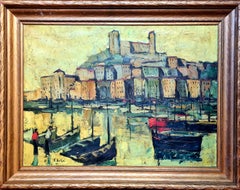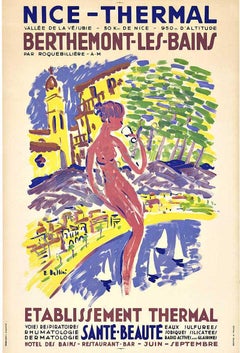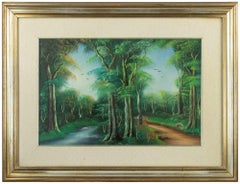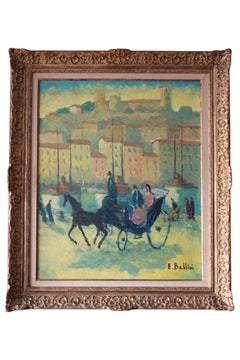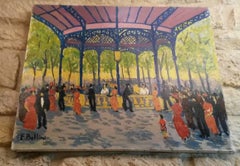Emmanuel Bellini Art
to
1
1
Overall Width
to
Overall Height
to
2
1
1
1
1
1
1
1
1
1
1
1
1
2
8,232
2,807
1,650
1,318
1
1
1
Artist: Emmanuel Bellini
Large French Post Impressionist Oil on Canvas, The Port of Cannes at Crépuscule
By Emmanuel Bellini
Located in Cotignac, FR
Large French Post Impressionist oil on canvas view of the Port of Cannes in the South of France by Moroccan Monegasque painter Emmanuel Bellini. The painting is signed bottom left an...
Category
Mid-20th Century Modern Emmanuel Bellini Art
Materials
Canvas, Oil
Original Nice-Themal spa Berthemont - Les -Bains antique French vintage poster
By Emmanuel Bellini
Located in Spokane, WA
Original French travel poster: Nice - Thermal health spa original vintage poster created by artist Emmanuel Bellini.
Original linen backed, large French travel size: Nice - Therm...
Category
1950s Impressionist Emmanuel Bellini Art
Materials
Lithograph
Related Items
Exotic Landscape - Painting by Kabemba Situna WA - 1970s
Located in Roma, IT
Exotic Landscape is an artwork realized by Kabemba Situna Wa.
Oil on Canvas, 1970s.
38 x 58 cm ; 65 x 85 cm with frame.
Good conditions
Category
1970s Modern Emmanuel Bellini Art
Materials
Canvas, Oil
$504 Sale Price
25% Off
H 14.97 in W 22.84 in D 0.79 in
Spanish town street oil on canvas painting Spain urbanscape
By Rafael Fernández de Soto
Located in Barcelona, Barcelona
Rafael de Soto - Village street - Oil on canvas
Oil measurements 41x33 cm.
Without frame.
Category
1940s Modern Emmanuel Bellini Art
Materials
Oil, Canvas
$660 Sale Price
44% Off
H 16.15 in W 13 in
1960's French Modernist Signed Oil Man Driving 1900's Vintage Car
Located in Cirencester, Gloucestershire
Artist/ School: Jean-Pierre Rousseau (French, b. 1939), signed and dated 1963.
Title: The Vintage Car Driver
Medium: signed oil painting on canvas, framed and inscribed verso.
f...
Category
Mid-20th Century Modern Emmanuel Bellini Art
Materials
Canvas, Oil
$926 Sale Price
30% Off
H 16.75 in W 19.75 in
Mountain & Lake in Ireland Countryside - Oil Painting by Northern Irish Artist
Located in Preston, GB
Mountain & Lake in Ireland Countryside - Oil Painting by Northern Irish Artist, Dennis Orme Shaw
Art measures 12 x 10 inches
Frame measures 18 x 16 inches
Dennis Orme Shaw was b...
Category
20th Century Modern Emmanuel Bellini Art
Materials
Canvas, Oil
Dennis Orme ShawMountain & Lake in Ireland Countryside - Oil Painting by Northern Irish Artist, 1980
$1,281 Sale Price
20% Off
H 16 in W 18 in D 2 in
France World Cup Lithograph by Aldo Luongo c.1998
By Aldo Luongo
Located in San Francisco, CA
FRANCE World Cup Lithograph by Aldo Luongo c.1998
Limited edition France 98' World Cup - Official License
From a very limited edition of 300.
Pencil signed lower right. Edition 24/300 lower left.
This is a rare, very small edition lithograph for the 1998 Soccer World Cup...
Category
Late 20th Century Impressionist Emmanuel Bellini Art
Materials
Lithograph
Morning Sunrise, Mid Century Laguna Hills Figurative Landscape
Located in Soquel, CA
Beautiful mid century plein air figural landscape of Laguna Niguel, California by an unknown artist (American, 20th Century). The morning sun gli...
Category
1950s American Modern Emmanuel Bellini Art
Materials
Canvas, Oil, Cardboard
$719 Sale Price
20% Off
H 20 in W 24 in D 2 in
Large Modernist French Landscape with Figures Sunbathing by the River Signed Oil
By Huguette Ginet-Lasnier
Located in Cirencester, Gloucestershire
On the River
Huguette Ginet-Lasnier (French 1927-2020)
signed and inscribed verso
in a wooden frame
oil painting on canvas
framed: 29 x 37 inches
All the paintings we have for sale b...
Category
21st Century and Contemporary Modern Emmanuel Bellini Art
Materials
Canvas, Oil
$1,413 Sale Price
30% Off
H 29 in W 37 in
Large 1960's Modernist Signed Oil Painting Venice Grand Canal Atmospheric Work
Located in Cirencester, Gloucestershire
The Grand Canal, Venice
Alvarez ( Mid 20th Century)
signed oil on canvas, framed
framed: 25 x 33 inches
canvas: 20 x 28 inches
provenance: private collection, France
condition: very ...
Category
Mid-20th Century Modern Emmanuel Bellini Art
Materials
Oil, Canvas
$975 Sale Price
30% Off
H 25 in W 33 in
Historic American School Modernist WPA New York City Shipping Dock Oil Painting
Located in Buffalo, NY
Antique American modernist New York City dock scene. Oil on canvas. In excellent original condition. Handsomely framed in a period modern molding. Excellent condition, ready to...
Category
1930s Modern Emmanuel Bellini Art
Materials
Canvas, Oil
$4,600 Sale Price
20% Off
H 19 in W 23 in D 2 in
After Keith Haring, Lithograph, Numbered 95/150
By (after) Keith Haring
Located in Pasadena, CA
After Keith Haring, Limited Edition of 95/150
Artwork lithograph prints by Keith Haring Foundation, numbered with embossed stamp.
The image features the world famous American Pop art...
Category
1980s Pop Art Emmanuel Bellini Art
Materials
Lithograph
Mother and Children
By Edna Hibel
Located in San Francisco, CA
This artwork "Mother and Children" c.1970, is a colors lithograph on paper by American artist Edna Hibel, 1917-2014. It is signed and numbered II 3/10 Ed. 200 in pencil by the artist. The The artwork (sheet ) size is 34 x 23 inches, framed size is 40 x 29 inches. Custom framed in original wooden decorated grey/silver frame. It is in excellent condition.
About the artist:
Edna Hibel, a painter of sentimental pictures of children, has had a more than 60-year career as painter and lithographer and promoter of peace through exhibitions of her artwork.
She was born in 1917 in Boston, Massachusetts. Her parents were Abraham and Lena Hibel, and she was raised in the Boston area and educated at Brookline High School where she met her future husband, Theodore Plotkin.
She began to paint when she was nine years old and learned watercolor during summers at the shore where her family vacationed in Maine and Hull, Massachusetts.
Hibel studied at the Boston Museum School of Fine Arts, from 1935-39, receiving a Sturtevant Traveling Fellowship to Mexico. In Boston, in 1966, she began lithography, continuing in 1970 in Zurich, where she still works every year. She has created lithographic works with up to 32 stones (or colors) on paper, silk, wood veneer and porcelain. The latter pieces are called lithographs on porcelain and result from a complicated process, that she keeps a secret, whereby she transfers stone lithographic color separations onto Bavarian hard paste porcelain. Hibel has created the "Arte Ovale" series and various plaques with this technique.
She organized the Edna Hibel Museum of Art, in Jupiter, Florida, to display and promote her work and also created a United Nations stamp, "Mother Earth."
In 1995, she was commissioned by the Foundation of the U.S. National Archives to commemorate the 75th anniversary of women receiving the universal right to vote. At the ceremony, Ms. Lucy Baines Johnson referred to Hibel as the "Heart and Conscience of America."
In November, 2001, the World Cultural Council based in Mexico City gave her the Leonardo da Vinci World Award of Arts.
Hibel's work has been exhibited in museums and galleries in more than 20 countries including Russia, Brazil, China, Costa Rica, and the United States, and under the royal patronage of Count and Countess Bernadotte of Germany, Count Thor Bonde of Sweden, Prince and the late Princess Rainier of Monaco and Her Majesty Queen Elizabeth II of England.
Pope John Paul II gave her a medal of honor as did the late Belgian King Baudouin. She also received honorary Doctoral degrees including from Eureka College, and Northwood University of Florida, Michigan and Texas. She also has received many humanitarian honors for her charitable efforts for children's and medical charities.
Her exhibitions "Golden Bridge" and " Peace Through Wisdom" were efforts to promote peace and cultural understanding between China, the United States, Yugoslavia and Russia, and a television documentary titled "Hibel's Russian Palette" was based on her trips and art shows in Leningrad, now St. Petersburg. In 2001, Edna received a Lifetime Achievement Award from "Women in the Visual Arts," an organization of artists in the South Florida area.
Works in Permanent Collections:
Harvard University
Boston University
Museum of Fine Arts, Boston
Springfield Museum of Arts, Massachusetts
University of New Hampshire
Fleischmann Collection, Cincinnati
Detroit Art Institute
Milwaukee Art Museum
Phoenix Art Museum
La Jolla Museum, California
Lowe Gallery, University of Miami, Florida
Columbus Museum of Arts and Crafts, Georgia
WarrenHall Coutts, Ill, Memorial Museum of Art, El Dorado, Kansas
Palais des Nations,Geneva, Switzerland
United Nations Headquarters, New York City
Norton Gallery, West Palm Beach, Florida
de Saisset Museum, Santa Clara, California
Russian Academy of Art, St. Petersburg, Russia
Hibel Museum of Art, Lake Worth, Florida
One Artist Exhibitions:
Shacknow Museum of Fine Arts, Plantation, Florida, 2000
Cornell Museum of Art and History, Delray Beach, Florida, 1999 (and 1993)
Klutznick National Jewish Museum, Washington, D.C., 1999
The Museum of Printing History, Houston, Texas, 1999 (and 1998)
Mitsukoshi Fine Art Gallery, Tokyo, Japan, 1995 (and 1994)
Lyme Academy of Fine Art, Old Lyme, Connecticut, 1994
Grenchen Art Museum, and Galerie BrechbUhl, Grenchen, Switzerland, 1992
Soviet Union Academy of Art, and Exhibition Hall of the Russian Union of Artists, Leningrad (St. Petersburg),
Russia, U.S.S.R., 1990
Northern Indiana Arts Association Gallery, Munste~ Indiana, 1990
Galerie Vindobona, Bad Kissingen,West Germany, 1988
The National Museum of Women in the Arts, Washington, D.C., 1989
St. Peter An...
Category
Late 20th Century American Impressionist Emmanuel Bellini Art
Materials
Lithograph
Ruth and Boaz
By Marc Chagall
Located in Washington, DC
Artist: Marc Chagall
Title: Ruth and Boaz
Portfolio: Drawings for the Bible
Medium: Lithograph
Year: 1960
Edition: Unnumbered
Frame Size: 22 1/4" x 18 3/4"
Sheet Size: 14 3/8" x 10 1...
Category
1960s Emmanuel Bellini Art
Materials
Lithograph
Previously Available Items
Large Vintage Landscape/Figurative oil painting horse & cart by Emmanuel Bellini
By Emmanuel Bellini
Located in AIGNAN, FR
*RESERVED*Amazing large framed oil on canvas of a horse and carriage on the promanade in Cannes, French Riviera. Here, this renown French Artist, Emmanuel Bellini has given us a larg...
Category
Late 20th Century Post-Impressionist Emmanuel Bellini Art
Materials
Oil
La Belle Epoque of the Vichy Baths by Emmanuel Bellini
By Emmanuel Bellini
Located in Paris, FR
Vivid colours oil on canvas from the 60's by the famous French listed artist Emmanuel BELLINI ( 1904-1989 ), depicting the Belle epoque period and its kiosk of the thermal natural springs at the VICHY Spa in the begining of the 20th century named Belle Epoque.
The painting is post impressionnist style and the resort atmosphère perfectly rendered.
The oil is in excellent condition, signed on the left bottom, again on the back and titled.
Sold unframed.
Dimensions : 73 cm x 60 cm 28.74 in. x 23.62 in.
About thé artist :
Emmanuel Bellini b: 1904 d: 1989
Bellini was born in Monaco during the “Belle Epoque” era to a working class loving family of Italian descent. Surrounded by an idyllic setting where the air was perfumed by the flowers and fruits of the Mediterranean, meeting with the the colors of the sky, sun and earth. This formed an indelible palette in the young mind of this artist. An era of horse drawn carriages, polite society, the nearby theatre and opera house, all appealed and stimulated the senses of the young man who set to work as an apprentice in Nice for the architect Charles Damas, who was instrumental in the designs of the famous Paris Opera House and that of Monaco.
Later becoming an architect himself, in his search of the purity of the line, his internal compass directed him to the sea, the sailboats, the magical backdrop of the Casino and its gardens which persisted to inspire and capture his imagination. This led him to create his iconic posters for the Automobile Club of Monaco, as well as the special Galas and events of Monaco, and the city of Cannes. It was only a matter of time before his paintings were brought to the attention of the outside world. First exhibiting in 1949 at the Galerie Lambert in Paris, and quickly followed by the famed Galerie Petrides leading to many other exhibits in various galleries across the cities of Europe. His style is unique, reminiscent of far away impressionism, but with accents of fauvism.
With his success, Bellini purchased the baroque Italian Chapel in Cannes formerly owned by the Princess Kara-Georgevich of Serbia. Complete with bell tower and garden, it became his studio, and where he entertained the many luminaries who would visit him from the musicians of his day (Mireille Mathieu, Tino Rossi, Manitas de Plata…) to the artists ( Marie Laurencin, Maurice Utrillo, Carzou, Miro, Brayer…)to the celebrities and royalty (Lilly Pons, Prince Rainier III of Monaco, Mitty Goldin among many others). Here in this beautiful setting, he recreated the settings of the 1930’s that so intrigued him throughout his life in oil and water colors. His love of the theatre and music propelled him to create sets for opera and theatre houses...
Category
1960s Post-Impressionist Emmanuel Bellini Art
Materials
Canvas, Oil
H 23.63 in W 28.75 in
The Sorbet Merchant
By Emmanuel Bellini
Located in Paris, FR
The sorbets merchant.
Beautiful oil on cardboard from the late 40's by the famous French listed artist Emmanuel BELLINI, 1904 -1989 depicting a scene of life in summer in the French ...
Category
1940s Fauvist Emmanuel Bellini Art
Materials
Canvas, Oil
Men playing cards on the beach, French Riviera
By Emmanuel Bellini
Located in Paris, FR
Joueurs de carte à la plage, Men playing cards on the beach on the French Riviera.
Beautiful oil on cardboard from the late 40's by the famous French listed artist Emmanuel BELLINI, 1904 -1989 depicting a scene in summer with men playing cards on a beach on the French Riviera.
The painting whose tones have accents of Fauvism and Impressionism is one of the first works of the artist begining his carreer as a painter in 1948.
The painting is signed at the bottom left and again on the back, dated 49 and titled.
Sold unframed.
Dimensions : 61 cm x 50 cm 24.0 in. x 19.68 in.
About thé artist :
Emmanuel Bellini b: 1904 d: 1989
Bellini was born in Monaco during the “Belle Epoque” era to a working class loving family of Italian descent. Surrounded by an idyllic setting where the air was perfumed by the flowers and fruits of the Mediterranean, meeting with the the colors of the sky, sun and earth. This formed an indelible palette in the young mind of this artist. An era of horse drawn carriages, polite society, the nearby theatre and opera house, all appealed and stimulated the senses of the young man who set to work as an apprentice in Nice for the architect Charles Damas, who was instrumental in the designs of the famous Paris Opera House and that of Monaco.
Later becoming an architect himself, in his search of the purity of the line, his internal compass directed him to the sea, the sailboats, the magical backdrop of the Casino and its gardens which persisted to inspire and capture his imagination. This led him to create his iconic posters for the Automobile Club of Monaco, as well as the special Galas and events of Monaco, and the city of Cannes. It was only a matter of time before his paintings were brought to the attention of the outside world. First exhibiting in 1949 at the Galerie Lambert in Paris, and quickly followed by the famed Galerie Petrides leading to many other exhibits in various galleries across the cities of Europe. His style is unique, reminiscent of far away impressionism, but with accents of fauvism.
With his success, Bellini purchased the baroque Italian Chapel in Cannes formerly owned by the Princess Kara-Georgevich of Serbia. Complete with bell tower and garden, it became his studio, and where he entertained the many luminaries who would visit him from the musicians of his day (Mireille Mathieu, Tino Rossi, Manitas de Plata…) to the artists ( Marie Laurencin, Maurice Utrillo, Carzou, Miro, Brayer…)to the celebrities and royalty (Lilly Pons, Prince Rainier III of Monaco, Mitty Goldin among many others). Here in this beautiful setting, he recreated the settings of the 1930’s that so intrigued him throughout his life in oil and water colors. His love of the theatre and music propelled him to create sets for opera and theatre houses...
Category
1940s Fauvist Emmanuel Bellini Art
Materials
Canvas, Oil
Men playing cards on the beach, French Riviera
By Emmanuel Bellini
Located in Paris, FR
Joueurs de carte à la plage, Men playing cards on the beach on the French Riviera.
Beautiful oil on cardboard from the late 40's by the famous French listed artist Emmanuel BELLINI, 1904 -1989 depicting a scene in summer with men playing cards on a beach on the French Riviera.
The painting whose tones have accents of Fauvism and Impressionism is one of the first works of the artist begining his carreer as a painter in 1948.
The painting is signed at the bottom left and again on the back, dated 49 and titled.
Sold unframed.
Dimensions : 61 cm x 50 cm 24.0 in. x 19.68 in.
About thé artist :
Emmanuel Bellini b: 1904 d: 1989
Bellini was born in Monaco during the “Belle Epoque” era to a working class loving family of Italian descent. Surrounded by an idyllic setting where the air was perfumed by the flowers and fruits of the Mediterranean, meeting with the the colors of the sky, sun and earth. This formed an indelible palette in the young mind of this artist. An era of horse drawn carriages, polite society, the nearby theatre and opera house, all appealed and stimulated the senses of the young man who set to work as an apprentice in Nice for the architect Charles Damas, who was instrumental in the designs of the famous Paris Opera House and that of Monaco.
Later becoming an architect himself, in his search of the purity of the line, his internal compass directed him to the sea, the sailboats, the magical backdrop of the Casino and its gardens which persisted to inspire and capture his imagination. This led him to create his iconic posters for the Automobile Club of Monaco, as well as the special Galas and events of Monaco, and the city of Cannes. It was only a matter of time before his paintings were brought to the attention of the outside world. First exhibiting in 1949 at the Galerie Lambert in Paris, and quickly followed by the famed Galerie Petrides leading to many other exhibits in various galleries across the cities of Europe. His style is unique, reminiscent of far away impressionism, but with accents of fauvism.
With his success, Bellini purchased the baroque Italian Chapel in Cannes formerly owned by the Princess Kara-Georgevich of Serbia. Complete with bell tower and garden, it became his studio, and where he entertained the many luminaries who would visit him from the musicians of his day (Mireille Mathieu, Tino Rossi, Manitas de Plata…) to the artists ( Marie Laurencin, Maurice Utrillo, Carzou, Miro, Brayer…)to the celebrities and royalty (Lilly Pons, Prince Rainier III of Monaco, Mitty Goldin among many others). Here in this beautiful setting, he recreated the settings of the 1930’s that so intrigued him throughout his life in oil and water colors. His love of the theatre and music propelled him to create sets for opera and theatre houses...
Category
1940s Fauvist Emmanuel Bellini Art
Materials
Canvas, Oil
Men playing cards on the beach, French Riviera
By Emmanuel Bellini
Located in Paris, FR
Joueurs de carte à la plage, Men playing cards on the beach on the French Riviera.
Beautiful oil on cardboard from the late 40's by the famous French liste...
Category
1940s Fauvist Emmanuel Bellini Art
Materials
Canvas, Oil
The Sorbet Merchant
By Emmanuel Bellini
Located in Paris, FR
The sorbets merchant.
Beautiful oil on cardboard from the late 40's by the famous French listed artist Emmanuel BELLINI, 1904 -1989 depicting a scene of life in summer in the French Riviera with a sorbet merchant. The painting whose tones have accents of Fauvism and Impressionism is one of the first works of the artist.
The painting is signed at the bottom left and again on the back, dated 49 and titled.
Sold unframed.
Dimensions : 61 cm x 50 cm 24.0 in. x 19.68 in.
About thé artist :
Emmanuel Bellini b: 1904 d: 1989
Bellini was born in Monaco during the “Belle Epoque” era to a working class loving family of Italian descent. Surrounded by an idyllic setting where the air was perfumed by the flowers and fruits of the Mediterranean, meeting with the the colors of the sky, sun and earth. This formed an indelible palette in the young mind of this artist. An era of horse drawn carriages, polite society, the nearby theatre and opera house, all appealed and stimulated the senses of the young man who set to work as an apprentice in Nice for the architect Charles Damas, who was instrumental in the designs of the famous Paris Opera House and that of Monaco.
Later becoming an architect himself, in his search of the purity of the line, his internal compass directed him to the sea, the sailboats, the magical backdrop of the Casino and its gardens which persisted to inspire and capture his imagination. This led him to create his iconic posters for the Automobile Club of Monaco, as well as the special Galas and events of Monaco, and the city of Cannes. It was only a matter of time before his paintings were brought to the attention of the outside world. First exhibiting in 1949 at the Galerie Lambert in Paris, and quickly followed by the famed Galerie Petrides leading to many other exhibits in various galleries across the cities of Europe. His style is unique, reminiscent of far away impressionism, but with accents of fauvism.
With his success, Bellini purchased the baroque Italian Chapel in Cannes formerly owned by the Princess Kara-Georgevich of Serbia. Complete with bell tower and garden, it became his studio, and where he entertained the many luminaries who would visit him from the musicians of his day (Mireille Mathieu, Tino Rossi, Manitas de Plata…) to the artists ( Marie Laurencin, Maurice Utrillo, Carzou, Miro, Brayer…)to the celebrities and royalty (Lilly Pons, Prince Rainier III of Monaco, Mitty Goldin among many others). Here in this beautiful setting, he recreated the settings of the 1930’s that so intrigued him throughout his life in oil and water colors. His love of the theatre and music propelled him to create sets for opera and theatre houses...
Category
1940s Fauvist Emmanuel Bellini Art
Materials
Canvas, Oil
The Sorbet Merchant
By Emmanuel Bellini
Located in Paris, FR
The sorbets merchant.
Beautiful oil on cardboard from the late 40's by the famous French listed artist Emmanuel BELLINI, 1904 -1989 depicting a scene of life in summer in the French ...
Category
1940s Fauvist Emmanuel Bellini Art
Materials
Canvas, Oil
La Belle Epoque of the Vichy Baths by Emmanuel Bellini
By Emmanuel Bellini
Located in Paris, FR
Vivid colours oil on canvas from the 60's by the famous French listed artist Emmanuel BELLINI ( 1904-1989 ), depicting the Belle epoque period and its kiosk of the thermal natural springs at the VICHY Spa in the begining of the 20th century named Belle Epoque.
The painting is post impressionnist style and the resort atmosphère perfectly rendered.
The oil is in excellent condition, signed on the left bottom, again on the back and titled.
Sold unframed.
Dimensions : 73 cm x 60 cm 28.74 in. x 23.62 in.
About thé artist :
Emmanuel Bellini b: 1904 d: 1989
Bellini was born in Monaco during the “Belle Epoque” era to a working class loving family of Italian descent. Surrounded by an idyllic setting where the air was perfumed by the flowers and fruits of the Mediterranean, meeting with the the colors of the sky, sun and earth. This formed an indelible palette in the young mind of this artist. An era of horse drawn carriages, polite society, the nearby theatre and opera house, all appealed and stimulated the senses of the young man who set to work as an apprentice in Nice for the architect Charles Damas, who was instrumental in the designs of the famous Paris Opera House and that of Monaco.
Later becoming an architect himself, in his search of the purity of the line, his internal compass directed him to the sea, the sailboats, the magical backdrop of the Casino and its gardens which persisted to inspire and capture his imagination. This led him to create his iconic posters for the Automobile Club of Monaco, as well as the special Galas and events of Monaco, and the city of Cannes. It was only a matter of time before his paintings were brought to the attention of the outside world. First exhibiting in 1949 at the Galerie Lambert in Paris, and quickly followed by the famed Galerie Petrides leading to many other exhibits in various galleries across the cities of Europe. His style is unique, reminiscent of far away impressionism, but with accents of fauvism.
With his success, Bellini purchased the baroque Italian Chapel in Cannes formerly owned by the Princess Kara-Georgevich of Serbia. Complete with bell tower and garden, it became his studio, and where he entertained the many luminaries who would visit him from the musicians of his day (Mireille Mathieu, Tino Rossi, Manitas de Plata…) to the artists ( Marie Laurencin, Maurice Utrillo, Carzou, Miro, Brayer…)to the celebrities and royalty (Lilly Pons, Prince Rainier III of Monaco, Mitty Goldin among many others). Here in this beautiful setting, he recreated the settings of the 1930’s that so intrigued him throughout his life in oil and water colors. His love of the theatre and music propelled him to create sets for opera and theatre houses...
Category
1960s Post-Impressionist Emmanuel Bellini Art
Materials
Canvas, Oil
H 23.63 in W 28.75 in D 1.19 in
Men playing cards on the beach, French Riviera
By Emmanuel Bellini
Located in Paris, FR
Joueurs de carte à la plage, Men playing cards on the beach on the French Riviera.
Beautiful oil on cardboard from the late 40's by the famous French liste...
Category
1940s Fauvist Emmanuel Bellini Art
Materials
Canvas, Oil
Emmanuel Bellini art for sale on 1stDibs.
Find a wide variety of authentic Emmanuel Bellini art available for sale on 1stDibs. You can also browse by medium to find art by Emmanuel Bellini in lithograph and more. Much of the original work by this artist or collective was created during the 1950s and is mostly associated with the Impressionist style. Not every interior allows for large Emmanuel Bellini art, so small editions measuring 32 inches across are available. Customers who are interested in this artist might also find the work of Robert Daughters, Levon West, and Zamy Steynovitz. Emmanuel Bellini art prices can differ depending upon medium, time period and other attributes. On 1stDibs, the price for these items starts at $995 and tops out at $995, while the average work can sell for $995.
